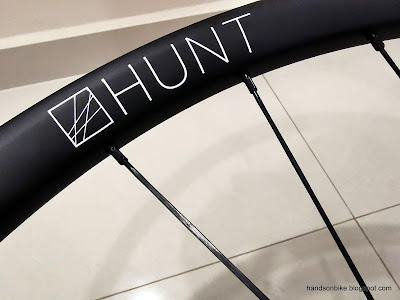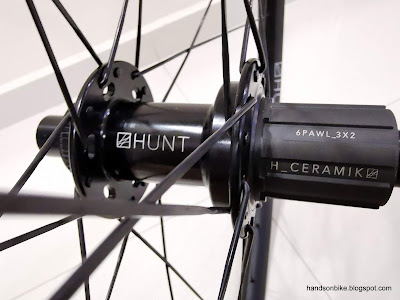I was really happy with the Panaracer GravelKing SK gravel tires that I used on the Canyon Endurace. Those were 700C tires with a claimed width of 32 mm. Therefore, I decided to get the same type of tires, but in a wider but smaller diameter 650B size. This time, I can fit wider tires since the Cervelo Aspero has a much bigger tire clearance.
Previously, when I installed the 32 mm wide (claimed) GravelKing SK tires on the DT Swiss G 1800 wheelset, the actual tire width became 35 mm, which is 3 mm wider than expected. This is probably due to the relatively wide internal rim width of 24 mm.
This time, I will also be installing the same brand of tire, on the Hunt 650B Adventure Carbon Disc wheelset which also has an internal rim width of 24 mm. Therefore, I am expecting the tire width to expand by about 3 mm as well.
The Cervelo Aspero has a frame clearance of about 57 mm when using 650B wheels. Given the recommended 4 mm of clearance between the tire and frame on both sides, the maximum tire width that can fit safely is about 49 mm.
I wanted to use the widest tire possible, but without going too close to the frame. The area with the tightest tire clearance is almost always between the chain stays, just behind the bottom bracket.
Panaracer GravelKing SK 650B tire comes in two tire widths, 1.75" and 1.9", which roughly translates to 43 mm wide and 48 mm wide. However, if I use choose the 48 mm width tire, it may expand by 3 mm, making it 51 mm wide and too big to fit safely into the frame.
Therefore, I decided to get the 43 mm wide version, as I am expecting it to expand by 3 mm, making it about 46 mm wide. At this point in time (January 2020), the 43 mm version was still very new, and it was very difficult to get hold of it, until I found it available on one website. If you are in Singapore, you can probably get it from The Bike Settlement, which is the official distributor of Panaracer tires.
New Panaracer GravelKing SK tires, in 650B size!
It has 5 rows of knobs, instead of 3 as found on the narrower 700C version.
Nice and wide size! 650B is the same as 27.5", which means that MTB 27.5" rims and tires are interchangeable with 650B. Official ETRTO size is 43-584.
Lots of knobs and "hair" on each knob of the tire.
Each tire weighs 460 grams, which is about 200 grams more than a typical Continental GP4000 700x28C road tire. This is due to much more rubber from the width and knobs.
650B inner tubes are also necessary. These inner tubes can be used for wider MTB tires as well.
Each Schwalbe SV21 inner tube weighs 199 grams, which is again additional weight over slimmer road inner tubes.
By now, you can see that using smaller 650B wheels will not give you any weight savings, as the heavier tires and inner tubes more than compensates for any weight reduction from the smaller rim and shorter spokes.
Shape of the tire after being installed and inflated. Lots of knobs for grip!
However, the actual width of the tire is 43 mm, which is the same as claimed.
Official tire width is 43 mm, but no one knows which rim width was used.
To my surprise, the actual tire width and the claimed width is the same at 43 mm. There was no additional tire width created by mounting on the 24 mm (internal) wide rim. I was quite disappointed as I expected the tire width to become wider, as I wanted to run tires that were as wide as possible.
Perhaps, the previous 700C tire width was judged on narrower rims, while these new 650B tires are judged on wider rims. That could be a reason why the actual width was the same as claimed. If I had gotten the wider 48 mm Panaracer GravelKing SK tires, they might have turned out to be exactly 48 mm, which would fulfill my plan to have the widest possible tires.
Regardless, since I already have the tires, I will put them on and give it a try. Here is how it looks when mounted on the Hunt wheelset!
Panaracer GravelKing SK 650B tires installed on the Hunt 650B Adventure Carbon Disc wheelset.
Front wheel + tire + inner tube weighs 1336 grams.
Rear wheel + tire + inner tube weighs 1451 grams.
Deore XT MT800 160 mm disc rotors installed on the front wheel.
MT800 160 mm disc rotors and HG800 11-34T 11 speed cassette installed on the rear wheel.
Both wheels are ready to go, since the disc rotors and cassette have been installed.
Complete front wheel after adding the MT800 disc rotor weighs 1448 grams, about 200 grams more than the road front wheel.
Complete rear wheel after adding the MT800 disc rotor and cassette weighs 1900 grams, about 300 grams more than the road rear wheel.
Note that this 650B gravel wheelset is LIGHTER than the 700C gravel wheelset which I used on the Canyon Endurace, as the lighter carbon rims have managed to offset the heavier and wider 650B tires. Of course, the gravel wheelset is still about 500 grams heavier than the Reynolds carbon road wheelset, which I cannot avoid. The only way to reduce weight from the gravel wheelset is to use narrower and lighter tires, which defeats my objective of running wide tires at low pressure.
Just for fun, I installed the new Hunt 650B front wheel on the Canyon Endurace, just to see how it looks like.
43 mm wide, 650B tires on the Canyon Endurace front fork.
Still plenty of radial clearance, as the wheel diameter is smaller. However, there is practically no clearance at both sides of the tire.
The wide 650B rear wheel definitely cannot fit onto the Canyon Endurace, since there was already very little clearance when using the previous 35 mm wide tires. Of course, it is not safe to ride the Canyon Endurace with this 43 mm wide front tire, as there is no frame clearance.
You may have noticed that there is a difference in wheel diameter between this 650B wheelset and previous 700C road and gravel wheelsets. In the next post, a detailed comparison will be done to compare the sizes of these wheelsets.
































































